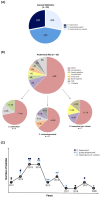The Threat Called Candida haemulonii Species Complex in Rio de Janeiro State, Brazil: Focus on Antifungal Resistance and Virulence Attributes
- PMID: 35736057
- PMCID: PMC9225368
- DOI: 10.3390/jof8060574
The Threat Called Candida haemulonii Species Complex in Rio de Janeiro State, Brazil: Focus on Antifungal Resistance and Virulence Attributes
Abstract
Although considered rare, the emergent Candida haemulonii species complex, formed by C. haemulonii sensu stricto (Ch), C. duobushaemulonii (Cd) and C. haemulonii var. vulnera (Chv), is highlighted due to its profile of increased resistance to the available antifungal drugs. In the present work, 25 clinical isolates, recovered from human infections during 2011-2020 and biochemically identified by automated system as C. haemulonii, were initially assessed by molecular methods (amplification and sequencing of ITS1-5.8S-ITS2 gene) for precise species identification. Subsequently, the antifungal susceptibility of planktonic cells, biofilm formation and susceptibility of biofilms to antifungal drugs and the secretion of key molecules, such as hydrolytic enzymes, hemolysins and siderophores, were evaluated by classical methodologies. Our results revealed that 7 (28%) isolates were molecularly identified as Ch, 7 (28%) as Chv and 11 (44%) as Cd. Sixteen (64%) fungal isolates were recovered from blood. Regarding the antifungal susceptibility test, the planktonic cells were resistant to (i) fluconazole (100% of Ch and Chv, and 72.7% of Cd isolates), itraconazole and voriconazole (85.7% of Ch and Chv, and 72.7% of Cd isolates); (ii) no breakpoints were defined for posaconazole, but high MICs were observed for 85.7% of Ch and Chv, and 72.7% of Cd isolates; (iii) all isolates were resistant to amphotericin B; and (iv) all isolates were susceptible to echinocandins (except for one isolate of Cd) and to flucytosine (except for two isolates of Cd). Biofilm is a well-known virulence and resistant structure in Candida species, including the C. haemulonii complex. Herein, we showed that all isolates were able to form viable biofilms over a polystyrene surface. Moreover, the mature biofilms formed by the C. haemulonii species complex presented a higher antifungal-resistant profile than their planktonic counterparts. Secreted molecules associated with virulence were also detected in our fungal collection: 100% of the isolates yielded aspartic proteases, hemolysins and siderophores as well as phospholipase (92%), esterase (80%), phytase (80%), and caseinase (76%) activities. Our results reinforce the multidrug resistance profile of the C. haemulonii species complex, including Brazilian clinical isolates, as well as their ability to produce important virulence attributes such as biofilms and different classes of hydrolytic enzymes, hemolysins and siderophores, which typically present a strain-dependent profile.
Keywords: Candida haemulonii complex; antifungal resistance; biofilm formation; hemolysins; hydrolytic enzymes; siderophores.
Conflict of interest statement
The authors declare no conflict of interest.
Figures



Similar articles
-
Candida haemulonii complex: species identification and antifungal susceptibility profiles of clinical isolates from Brazil.J Antimicrob Chemother. 2015 Jan;70(1):111-5. doi: 10.1093/jac/dku321. Epub 2014 Aug 18. J Antimicrob Chemother. 2015. PMID: 25134720
-
Candida parapsilosis (sensu lato) isolated from hospitals located in the Southeast of Brazil: Species distribution, antifungal susceptibility and virulence attributes.Int J Med Microbiol. 2015 Dec;305(8):848-59. doi: 10.1016/j.ijmm.2015.08.003. Epub 2015 Aug 14. Int J Med Microbiol. 2015. PMID: 26319940
-
Different classes of hydrolytic enzymes produced by multidrug-resistant yeasts comprising the Candida haemulonii complex.Med Mycol. 2017 Feb 1;55(2):228-232. doi: 10.1093/mmy/myw065. Epub 2016 Aug 23. Med Mycol. 2017. PMID: 27555559
-
The multidrug-resistant Candida auris, Candida haemulonii complex and phylogenetic related species: Insights into antifungal resistance mechanisms.Curr Res Microb Sci. 2025 Jan 28;8:100354. doi: 10.1016/j.crmicr.2025.100354. eCollection 2025. Curr Res Microb Sci. 2025. PMID: 39995443 Free PMC article. Review.
-
Insight into Virulence and Mechanisms of Amphotericin B Resistance in the Candida haemulonii Complex.J Fungi (Basel). 2024 Aug 28;10(9):615. doi: 10.3390/jof10090615. J Fungi (Basel). 2024. PMID: 39330375 Free PMC article. Review.
Cited by
-
Development of Echinocandin Resistance in Candida haemulonii: An Emergent, Widespread, and Opportunistic Fungal Pathogen.J Fungi (Basel). 2023 Aug 18;9(8):859. doi: 10.3390/jof9080859. J Fungi (Basel). 2023. PMID: 37623630 Free PMC article.
-
Molecular Characterization and Sterol Profiles Identify Nonsynonymous Mutations in ERG2 as a Major Mechanism Conferring Reduced Susceptibility to Amphotericin B in Candida kefyr.Microbiol Spectr. 2023 Aug 17;11(4):e0147423. doi: 10.1128/spectrum.01474-23. Epub 2023 Jun 26. Microbiol Spectr. 2023. PMID: 37358415 Free PMC article.
-
Comparative analyses of the biological characteristics, fluconazole resistance, and heat adaptation mechanisms of Candida auris and members of the Candida haemulonii complex.Appl Environ Microbiol. 2025 Apr 23;91(4):e0240624. doi: 10.1128/aem.02406-24. Epub 2025 Mar 26. Appl Environ Microbiol. 2025. PMID: 40135859 Free PMC article.
-
A Cluster of Diutina catenulata Funguria in Patients with Coronavirus Disease 2019 (COVID-19) Hospitalized in a Tertiary Reference Hospital from Rio de Janeiro, Brazil.Curr Microbiol. 2024 Sep 3;81(10):338. doi: 10.1007/s00284-024-03854-y. Curr Microbiol. 2024. PMID: 39223407
-
SARS-CoV-2 Post-Infection and Sepsis by Saccharomyces cerevisiae: A Fatal Case Report-Focus on Fungal Susceptibility and Potential Virulence Attributes.Trop Med Infect Dis. 2023 Feb 2;8(2):99. doi: 10.3390/tropicalmed8020099. Trop Med Infect Dis. 2023. PMID: 36828515 Free PMC article.
References
-
- Cendejas-Bueno E., Kolecka A., Alastruey-Izquierdo A., Theelen B., Groenewald M., Kostrzewa M., Cuenca-Estrella M., Gomez-Lopez A., Boekhout T. Reclassification of the Candida haemulonii Complex as Candida haemulonii (C. haemulonii Group I), C. duobushaemulonii Sp. Nov. (C. haemulonii Group II), and C. haemulonii var. vulnera var. Nov.: Three Multiresistant Human Pathogenic Yeasts. J. Clin. Microbiol. 2012;50:3641–3651. doi: 10.1128/Jcm.02248-12. - DOI - PMC - PubMed
-
- Ramos L.S., Figueiredo-Carvalho M.H., Barbedo L.S., Ziccardi M., Chaves A.L., Zancope-Oliveira R.M., Pinto M.R., Sgarbi D.B., Dornelas-Ribeiro M., Branquinha M.H., et al. Candida haemulonii Complex: Species Identification and Antifungal Susceptibility Profiles of Clinical Isolates from Brazil. J. Antimicrob. Chemother. 2015;70:111–115. doi: 10.1093/jac/dku321. - DOI - PubMed
-
- Silva L.N., Oliveira S.S.C., Magalhães L.B., Andrade Neto V.V., Torres-Santos E.C., Carvalho M.D.C., Pereira M.D., Branquinha M.H., Santos A.L.S. Unmasking the Amphotericin B Resistance Mechanisms in Candida haemulonii Species Complex. ACS Infect. Dis. 2020;6:1273–1282. doi: 10.1021/acsinfecdis.0c00117. - DOI - PubMed
Grants and funding
LinkOut - more resources
Full Text Sources

